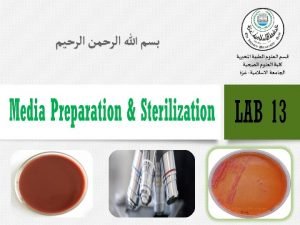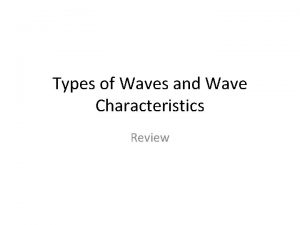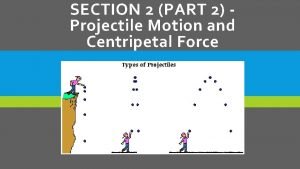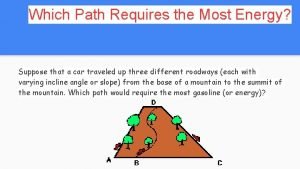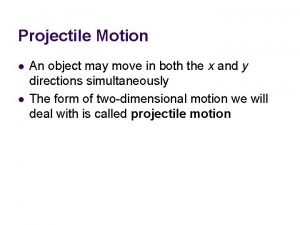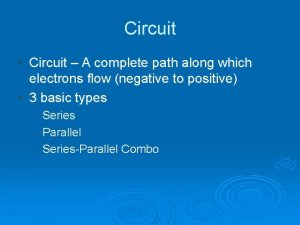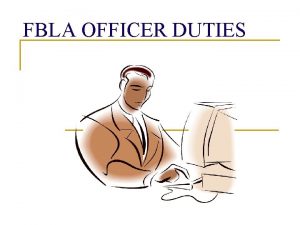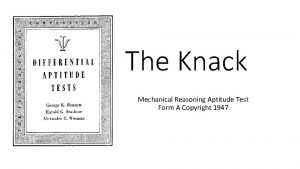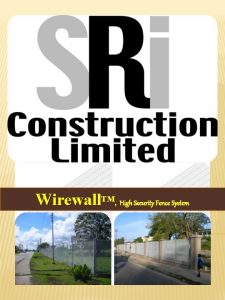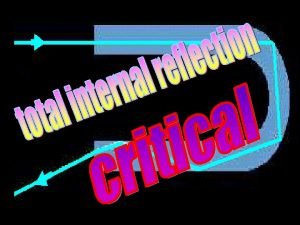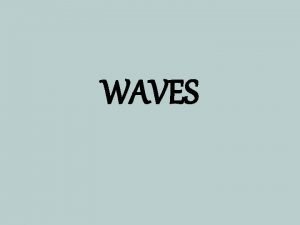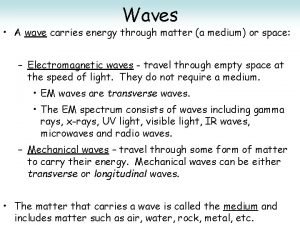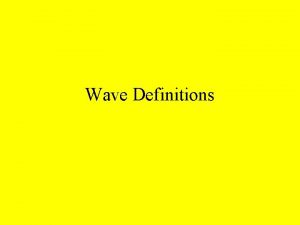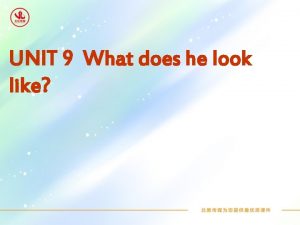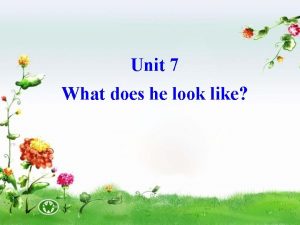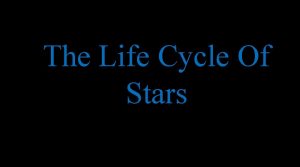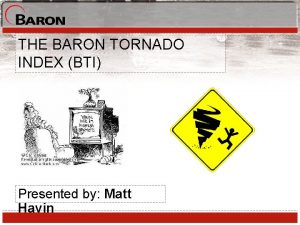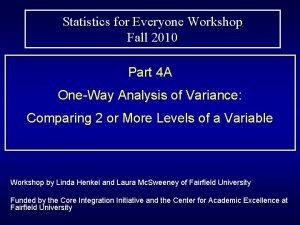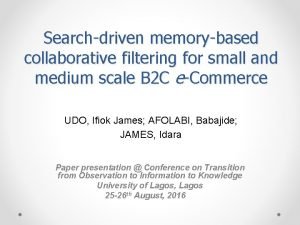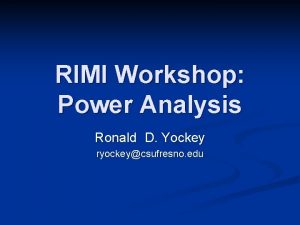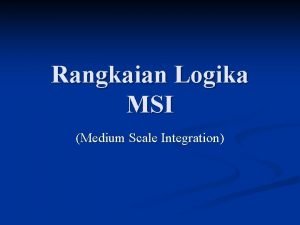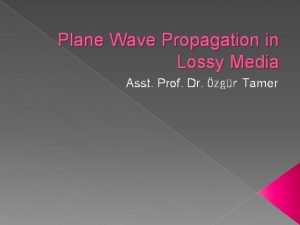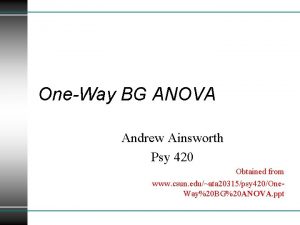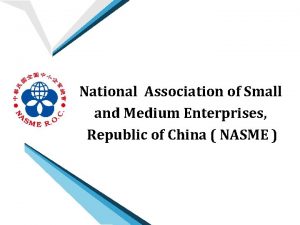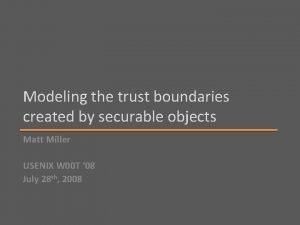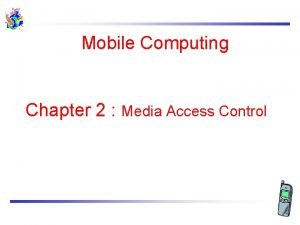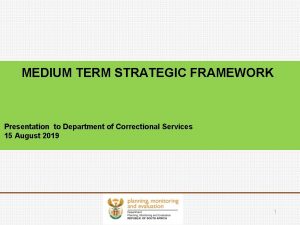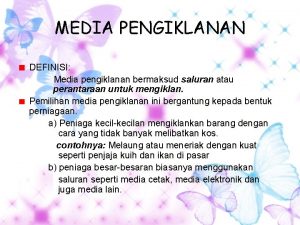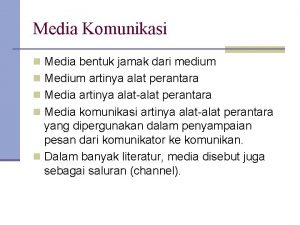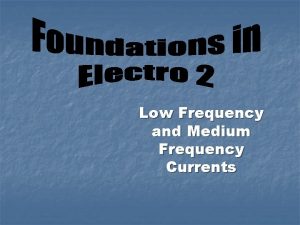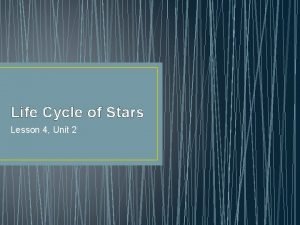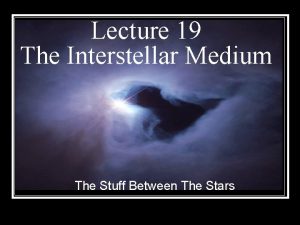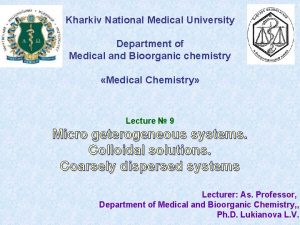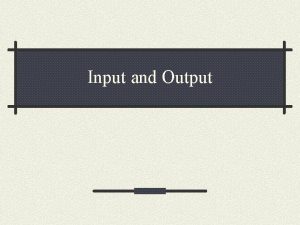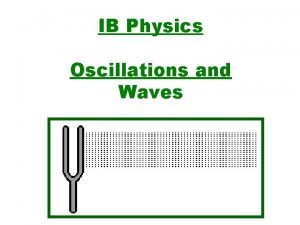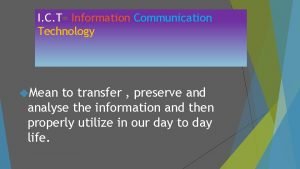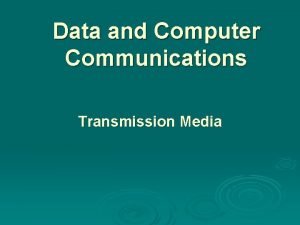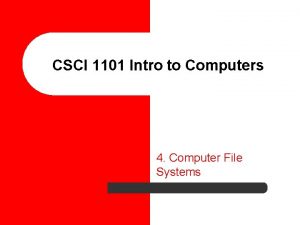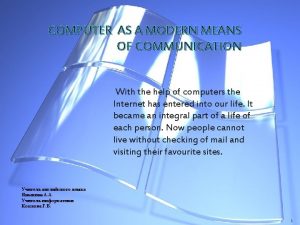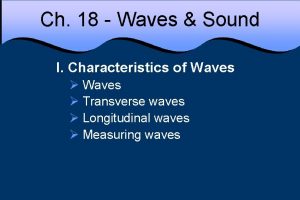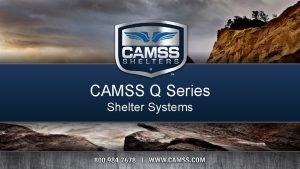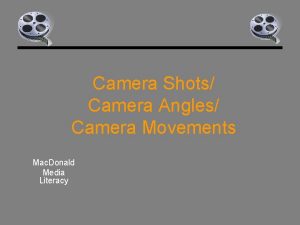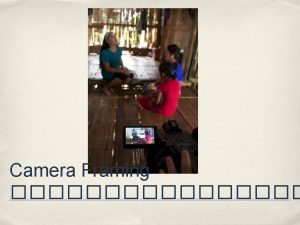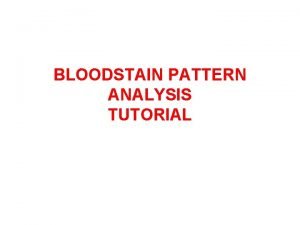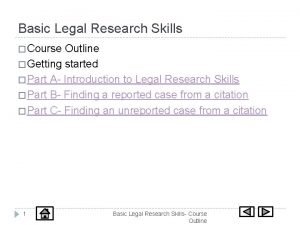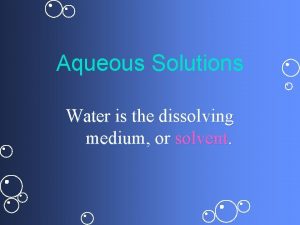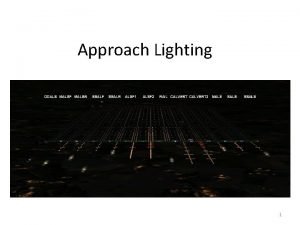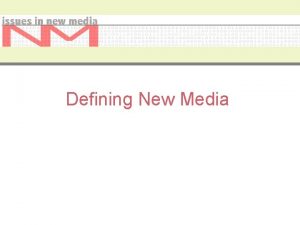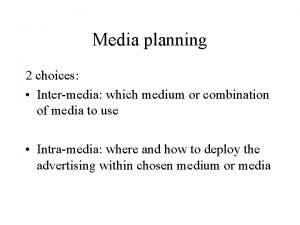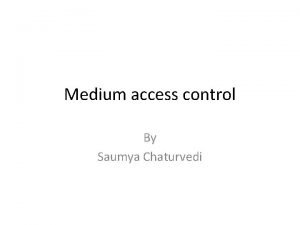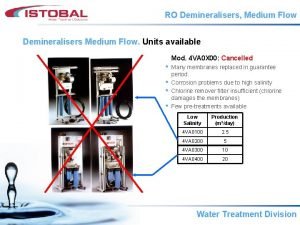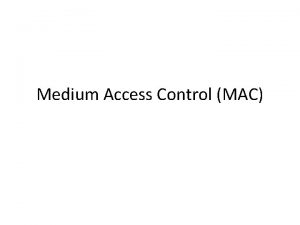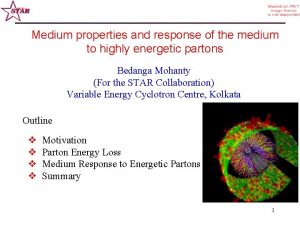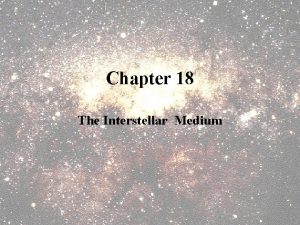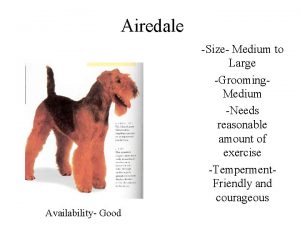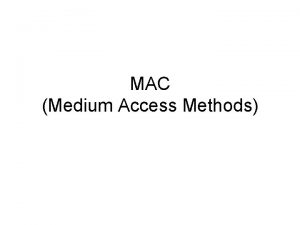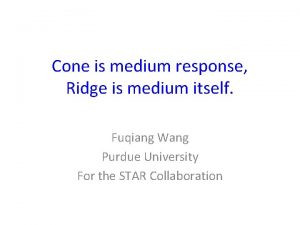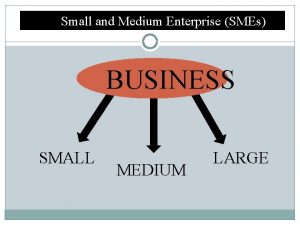Communications Media Communications Medium Media Path over which



























































































- Slides: 91

Communications Media • Communications Medium / Media: –Path over which, • Messages can be sent for, • Communication between the source and the receiver. – 2 types: • Guided Medium / Conducted Medium: –It is visible. –The device sends/conducts signals down the wire/cable. –Example: » Copper wire. • Unguided Medium / Radiated Medium: –It is invisible. –Signal is sent/radiated through the air by means of a transmitter and an antenna. –Example: » Airwaves.

Communications Media • Guided Media: –Visible and are part of the physical portion of the network. – 3 types of guided media: • Twisted pair wire. • Coaxial cable. • Fiber-optic cable.

Twisted Pair Wire Cable Jacket Insulator (Plastic) Twisted Pair Cable Conductor 1 pair / 2 pairs / 4 pairs Single Communication Line RJ-11 Connector RJ-45 Connector Telephone Computer

Guided Media • Twisted Pair Wire: –Most common transmission medium in use. –Construction / Composition: • Has a core that consists of, – 2 separate insulated copper wires, –Twisted (intertwined) together a specific number of times per foot where, –Each pair is considered a single communications line. • Each wire in a twisted pair is coated with, –An insulating material such as, » Plastic. • Bundles of twisted pair wires can be packed close together into one large cable. –The insulation keeps the copper wires from touching, –So the signal from one pair of wires does not interfere with the signal from any other pair of wires in the cable.

Guided Media • Twisted Pair Wire: –Need / Advantage of Twisting: • When electricity flows through any wire, –An electromagnetic field is generated. • This energy can create interference on surrounding wires. • When 2 wires are twisted together, –The pair generates less energy than a single wire. –So it makes the pair less susceptible to interference from neighboring wires. • Therefore by reducing interference, –Twisted pair wire provides a better quality media for transmission than wires without the twists.

Guided Media • Twisted Pair Wire: – 2 types: • Unshielded Twisted Pair (UTP) • Shielded Twisted Pair (STP)

Unshielded Twisted Pair Wire (UTP)

Shielded Twisted Pair Wire (STP)

Guided Media • Twisted Pair Wire: –Unshielded Twisted Pair (UTP): • Does not have the extra wire wrapping of shielded twisted pair (STP) wire and therefore, –Is more prone (susceptible) to interference. • However it is sufficient (adequate) in areas with less chances of noise / interference. –So often used in residential and office Telephone and Computer systems. • Most homes, use 2 pairs (4 UTP wires) to connect their telephones to the local end office. – 4 wires are used so that if a problem develops in 1 set of wires, the other set can be used until the problem is resolved. • Less expensive than STP wires.

Guided Media • Twisted Pair Wire: –Shielded Twisted Pair (STP): • Each pair of wires is placed into, –A separate shield to absorb any interference. • The wires are then put into a plastic outer shell. • Reliable for transmitting data in, –High-interference areas because the shielding prevents interference with the data. –Example: » Industry with large electronic equipments. • More expensive than UTP wires.

Coaxial Cable Connector

Guided Media • Coaxial Cable / Coax: –Construction / Composition: • Composed of a, –Single copper wire (Inner conductor), –Surrounded by an insulating material called, » Shell –Shell is surrounded by a seconductor called, » Copper Mesh / Copper Shield. » Gives the cable more electromagnetic protection than a twisted pair wire. • The entire cable is enclosed in a plastic outer shell called the, –Jacket. –Characteristics: • High-bandwidth medium that can carry thousands of signals at once. • Can transmit data over long distances than Twisted Pair wire. • Less susceptible/prone to interference than Twisted Pair wire.

Guided Media • Coaxial Cable: –Allows for 2 types of transmissions: • Broadband Transmission –Used by Cable Television Industry • Baseband Transmission –Used by Computers in a Local Area Network (LAN)

Broadband Transmission (Cable Television) Channel-1 Channel-2 Channel-3 Coaxial Cable Channel-5 ANALOG Transmission Channel-4

Baseband Transmission (Computers) DIGITAL Transmission

Guided Media • Coaxial Cable: –Broadband Transmission: • Used by cable television industry hence it is, –Analog Transmission • Single cable is logically divided by frequency into many channels, –Each carrying a different transmission separated by, –Guardbands to prevent, » Interference between the signals. • Using broadband transmission, a cable television company can, –Transmit multiple channels to individual homes using only a single cable. • Can also be used to transmit, –Voice, Video, Data and Alarm Signals simultaneously in a Home security system.

Guided Media • Coaxial Cable: –Baseband Transmission: • Only a single signal is transmitted over the cable. • Computers use baseband transmission to, –Send data to other computers in a local area network and hence it is, » Digital Transmission

Guided Media • Coaxial Cable: –In spite of high bandwidth offered by coaxial cable, • Twisted Pair (and not coaxial cable) is used more often in Computers and LAN’s because: –Coaxial cable is more expensive than Twisted Pair Wire. –Coaxial cable is difficult to install than Twisted Pair Wire. –Coaxial cable is much larger and heavier than Twisted Pair Wire. » Space required to store those cables is more.

Fiber-Optic Cable Optical Fiber

Fiber-Optic Cable Principle Bouncing/Reflection off the walls Total Internal Reflection

Guided Media • Fiber-Optic Cable: –Uses light to transmit data signals. –Construction / Composition: • Fiber-Optic Cable is composed of, –One or more thin strands of glass where, –Each strand of glass is called: » Optical Fiber • Each ‘Optical Fiber’ is as thin as, –A human hair and is surrounded by a layer called, –Reflective buffer or Cladding. • All the Optical Fibers are then enclosed in an outer covering called: –Jacket

Guided Media • Fiber-Optic Cable v/s Copper Wire: –Fiber-Optic Cable: • Signals are transmitted by means of light. • Speed is much faster than copper wire. –Copper Wire (Twisted Pair / Coaxial Cable): • Transmit signals electrically. • Speed is slower than fiber-optic cable.

Guided Media • Fiber-Optic Cable: – 2 types of fiber-optic cables based on, • The method used to transmit light down the cable. –Single-Mode Cable (Single Path / Single Signal): –Multi-Mode Cable (Multiple Paths / Multiple Signals): » Multimode Step Index » Multimode Graded Index

Fiber-Optic Cable Principle Properties Single-Mode Transfer less data faster over long distances. Diameter Required: Less Multi. Mode Step Index Multi. Mode Graded Index Transfer more data slower over short distances. Signal might suffer: Loss of Strength (Attenuation) So needs to be regenerated after certain distance. Diameter Required: More

Guided Media • Fiber-Optic Cable: –Advantages: • Offers high bandwidth. –Can transmit huge amounts of data at very high speeds. –Transmission speed starts from 100 Mbps and can go up to 2, 500, 000 Mbps. • Much thinner and lighter than, –Either twisted pair wire or coaxial cables. • More secure. –A copper wire is relatively easy to tap which, » Allows someone to steal data without the owner ever knowing that theft is occurring. –With optical fiber, however, a tap is very difficult to perform. • More immune (protection) to electrical interference. –With copper wires, broken insulation cause interference called: » Crosstalk. –Light waves do not interfere with each other even if the cables touch each other.

Guided Media • Fiber-Optic Cable: –Applications: • Generally used to link together, –LANs, WANs and other types of networks. • Are not used to link an individual PC to a LAN because of, –The high cost of the network interface cards and the other electronics needed.

Communications Media • Unguided Media: –Also called, • Wireless Media / Radiated Media which do not use, –Hard wires to transmit data. • Example: –Air is the best form of unguided media.

Unguided Media Transmitter Antenna Receiver Antenna Nature? Uni-directional / Omni-directional Directional / Un-directional

Communications Media • Unguided Media: –Question: • Can any company start sending any signals (through air) for communication? –Answer: • No. • Company needs to broadcast signals over specific frequency and, –Allocation of frequency is regulated / controlled by, » Some Government Regulatory Agency (such as TRAI) so that, » Different forms of communications do not interfere with one another. • Example: –If a new radio station wants to begin broadcasting, » It must get permission from Government Regulatory Agency to use the radio frequency over which it wants to broadcast.

Communications Media • Unguided Media: –Forms of transmission that use unguided media are: • Broadcast Radio • Microwave –Cellular Radio • Spread Spectrum Radio • Infrared transmission

Unguided Media Frequency Spectrum

Unguided Media Frequency Spectrum

Unguided Media • Broadcast Radio: –Nature/Properties: • Sends signals in a frequency range from, – 540 KHz to 300 MHz • Term usually is associated with: –Radio Broadcasting through Radio Stations. –Shortwave radio. –CB radio. –Television Transmission. • Most forms of Broadcast Radio are, –Omni-directional. » ‘Omni’ means ‘All / Every’. –Antenna that is used to receive the broadcast signal and, » Does not have to be positioned or pointed in a specific direction.

Broadcast Radio • Radio Broadcasting through Radio Stations: –AM Radio: • Stands for Amplitude Modulation Radio. • Transmits at a much Lower Frequency than FM Radio and hence, –Higher Wavelength than FM Radio and so, –Can be broadcast farther than FM Radio. • Interrupted easily by atmospheric changes such as thunderstorms. –FM Radio: • Stands for Frequency Modulation Radio. • Transmits at a much Higher Frequency than AM Radio and hence, –Lower Wavelength than AM Radio and so, –Cannot be broadcast farther than AM Radio. • Storm interference will not be noticeable.

Broadcast Radio • Shortwave Radio: –Used for communication in: • Military communications. • To give news during times of disaster. • CB Radio: –Stands for ‘Citizens Band Radio’. –Uses very low power and cannot transmit over long distances. –Was very popular in the 1970 s and 1980 s with travelers of all kinds. • Truck drivers used CB radios to check on road conditions or get directions to their destinations.

CB Radio

Broadcast Radio • Television Transmissions: –Television transmission antenna sends a television signal out, • In all the directions. –Omni-directional. –However, television receiving antenna (Yagi antenna) is, • Directional and so, –Pointing the television antenna more directly at the transmitting station will produce a better picture. –Uses higher frequency than AM & FM radio because, • More data consisting of both ‘Picture’ & ‘Sound’ need to be transferred. – 2 basic types of television frequencies are used: • VHF: –Very High Frequency –Frequencies from 50 to 225 MHz • UHF: –Ultra High Frequency –Frequencies from about 400 to 900 MHz

Broadcast Radio • Television Transmissions: –DTV (Digital Television Technology): • New technology that is used to transmit, –Television channels in Digital form rather than Analog form. • Decoder / Set-top box is used to decode the incoming signals. –HDTV (High-Definition Television): • Newer technology in DTV which, –Delivers a higher-quality picture than standard television.

Unguided Media • Microwave: –Nature/Properties: • Transmits signals between, – 2 or more stations in a frequency range of: » 3 GHz to 30 GHz (3, 000 MHz to 30, 000 MHz) • Signals have a high frequency and hence, –A short wavelength and so it is called, » Micro. • High frequency allows, –Large amounts of data to be transmitted over this medium.

Unguided Media • Microwave: –Nature/Properties (cntd): • Unlike ‘Broadcast Radio’ signals, which are omni-directional, –Microwave transmission is, » Uni-directional. • Signals produced by a microwave station, –Travel in a straight line and so, » The antennas used for transmission must be pointed directly at one another. –Also known as, » ‘LINE OF SIGHT’ transmission. • They can be affected by, –Atmospheric changes such as rain and snow and by, –Obstacles between the microwave stations.

Microwave Terrestrial Microwave To prevent obstacles, Stations (Transmission/Receiving) are placed on a height. Earth Satellite Microwave

Unguided Media • Microwave: – 2 types: • Terrestrial Microwave • Satellite Microwave

Microwave • Terrestrial Microwave: –Terrestrial means, • Related to ground / territory / earth. • So in terrestrial microwave, transmissions are sent between, – 2 microwave stations on Earth. –Because microwaves must travel in un-obstructed straight lines, • Ground-based microwave stations are placed, –On top of towers and, –At very short distances from one another. • If they were placed too far apart, –Earth’s curvature blocked the line-of-sight transmission. –Most common form of long-distance communications today as, • Major long-distance telephone companies have microwave transmission towers placed across the nation where, • Transmission could take place over 55 miles.

Microwave • Satellite Microwave: –Involves sending microwave transmissions between, • 2 or more Earth-based microwave stations and, • A satellite. –Satellite just serves as a, • Relay (Intermediate/Pass-on) station that receives signals from, –One Earth-based station and rebroadcasts it to the next.

Satellite Microwave Objectives: Cover as much area as possible. Remain in the same place with respect to relative motion of earth. Fo otp r int s Geosynchronous Orbit 0 0 2, 3 2 le mi m 0 k s 0 , 0 36 GEOS Geosynchronous Earth Orbiting Satellite Geostationary Earth Orbiting Satellite

Satellite Footprint

Microwave • Satellite Microwave: –Most communications satellites are placed into orbit at a distance which is, • 22, 300 miles above Earth’s surface known as, –Geosynchronous Orbit / Geostationary Orbit –At that distance, • Satellite keeps revolving in orbit at the same rate as that of Earth’s rotation due to, • Earth’s gravitational force and so, • Satellite appears to be in a fixed position over the Earth. –Such a satellite is called: • GEOS –Geo-synchronous Earth Orbiting Satellite –Geo-stationary Earth Orbiting Satellite –Part/Region of the earth that 1 satellite can cover is called: • Footprint. –Generally covers several countries. – 3 satellites appropriately positioned over the Earth can cover entire Earth.

Satellite Microwave ce Conversion to a different frequency. lo ng di st an Transponder Amplification is done. 2 different frequencies Time wastage Propagation Delay k U lin wn Do k in pl

Microwave • Satellite Microwave: –Propagation Delay: • Extra/Unnecessary time taken by the signal, –To travel from an Earth station to a satellite and back plus, –The time it takes to convert the signal to sending signal of different frequency. • Varies from, – 1 second for data transmission to, – 3 seconds for voice or television transmission. • Example: –Television: » When a reporter from one country interviews someone in another country. –Telephone: » Overseas telephone conversation also shows delay.

Microwave • Satellite Microwave: –Apart from GEOS satellites, other types of satellites also exist: • LEOS. • MEOS.

Microwave • Satellite Microwave: –LEOS: • Also known as, –Low Earth Orbiting Satellites. • Launched at a height of, – 325 to 1, 000 miles. • Do not move at the same speed as that of earth but, –Travel completely around the earth in 90 to 100 minutes. • Number of satellites needed to cover the entire earth is, – 12. • Advantage: –Decreased propagation delay as they are very close to earth. • Example: –Iridium Project.

Microwave • Satellite Microwave: –MEOS: • Also known as, –Medium Earth Orbiting Satellites. • Launched at a height of, – 6, 000 to 10, 000 miles above Earth. • Number of satellites needed to cover the entire earth is, – 6. • Example: –Teledisc Project.

GEOS, LEOS, MEOS

Microwave • Satellite Microwave: –Applications: • Telephone Communications • Computer Networking • Broadband Internet Access • Interactive Multimedia • Direct. TV –Videocon D 2 H, Tata. Sky, Dish. TV. • GPS

Microwave • Satellite Microwave: –GPS: • Also known as, –Global Positioning System. • Consists of, –Satellites and receivers that are used to, –Determine a location. • Made possible by, –US Global Positioning System consisting of, –A collection of 24 satellites, which are placed in orbit at a cost of $12 billion. • Algorithm/Method used to determine exact location on Earth is called, –Triangulation. • Used in, –Automobiles, airplanes, cell-phones etc.

Microwave • Satellite Microwave: –Cost of operation: • To use satellites, companies need to, –Rent satellites and transmit their data which could also be, » Very costly. • Cost of repairing a satellite also is very high. –In the past, » Satellites that stopped working properly simply were allowed to fail and were left in orbit. –Today, » NASA’s space shuttle program makes it possible to get a satellite back for repair.

Unguided Media Cellular Radio Why it is called ‘Cell Phone’ / ‘Cellular Communication’ ? Question: MH Can these many unique frequencies be available at a single time? z No. 750 95 8 00 Hz 0 M 90 Hz 0 M 890 MH z So the only solution is: To reuse one frequency multiple times. Question: But giving the same frequency in the same area to 2 users will create Interference. Entire City

Unguided Media Cellular Radio Entire city is divided into logical hexagonal shaped structures called: CELLS So it is called Cellular Communication.

Unguided Media Cellular Radio As a person moves from one cell to another, one cell leaves the signal and another cell catches it. Cell Phone Tower This is called ‘Hand-Off’.

Unguided Media • Cellular Radio: –The genius of the cellular system is: • The division of a city into small cells where, • Each cell has its own transmitting antenna which allows, • Frequency reuse across a city, so that, • Millions of people can use cell phones simultaneously. –It is a form of, • ‘Broadcast Radio’ with 1 exception: –It puts restrictions on how far the signal is transmitted by, –Operating the transmitters at a very low power so that, –Transmitters in adjacent cells can broadcast on the same frequency and not, » Interfere with one another.

Unguided Media • Cellular Radio: –Cellular Telephone: • Radio device that use cellular radio signals to transmit, –Voice and Data messages. –Hand-Off: • As a person with a mobile phone moves from one cell to another, –The signal is transferred from the transmitter in one cell to the transmitter in the next cell. • Process of, –Handing off the signal by one transmitter and, –Catching off the signal by another transmitter. • Sometimes, this change in transmitters will cause, –An interruption or even loss of the signal.

Unguided Media • Cellular Radio: –Problems associated: • Scanner: –Devices that can intercept (steal / listen to) cell phone conversations. –Require more security precautions that are not needed with standard telephones. • Cloning: –The theft of, » Some unique feature of the cell phone and duplicating that for, » Misuse.

Unguided Media • Spread Spectrum Radio (SSR): –Transmission of radio signals is, • Spread over multiple different frequencies rather than, • A single frequency. –Developed initially by, • The military to provide, –Protection against, –Eavesdropping (Spying / Listening In) and Jamming of radio signals. – 2 main methods: • Frequency-Hopping Spread Spectrum (FHSS) • Direct-Sequence Spread Spectrum (DSSS)

Spread Spectrum Radio • Frequency-Hopping Spread Spectrum: –Signal is broadcast over, • A large random series of radio frequencies by, –Transmitting a short time on one frequency and then, –Hopping to another frequency for another short time and so on. –So, instead of continuously transmitting on one frequency, • It switches rapidly from one frequency to the next. –The choice of the next frequency is, • Random and so, –It is very difficult for someone to eavesdrop or jam the signal. –The challenge is to, • Keep both the transmitter and receiver synchronized. • Done by, –Some precision ‘Clocks’ and ‘Pseudo. Random’ (False. Random) generation logics. –Used in: • Blue. Tooth

Spread Spectrum Radio • Direct Sequence Spread Spectrum: –Directly add a sequence of, • A random data bits (Noise) to the transmission so that, • The signal contains both, –A useful signal and, –A signal that appears to be interference (noise). –These random data bits are called: • Chips. –The receiver which is synchronized with the transmitter tries to, • Identify the chips / Decode the data and removes them leaving only, • The useful signal. –Used in: • Wireless LAN / Wi-Fi

Unguided Media • Infrared Transmission (IR): –Involves sending electromagnetic signals at a frequency between: • Radio Waves & Visible Light –Used in products such as: • Television Remote Controls. • Data transfer. –Type of transmission is: • Line-of-sight transmission. –Maximum coverage of: • 30 to 80 feet. –Ports which provide IR connectivity are called: • Ir. DA ports –Infrared Data Association

Communications Media (Classification) Communications Media Guided Media (Conducted Media) Unguided Media (Radiated Media) Types of Transmissions Types Twisted Pair UTP STP Coaxial Cable Fiber-Optic Cable Single-mode Multi-mode Step Index Broadband Graded Index Baseband Broadcast Microwave Cellular Spread Infrared Radio Spectrum Radio AM & FM Shortwave CB Radio Television Terrestrial Satellite FHSS DSSS

Communications Media • Selection of Media: –Many factors/parameters/criteria are involved in choosing the medium for a communications network. –Parameters might change depending on: • Existing Network: –Type of media already in use in an organization. –How much it would cost to replace the existing media. • New Network: –Cost of the medium. –Speed at which it can transmit. –Environment in which the medium is used. –Security of the data transmitted over the medium.

Selection of Media • Cost: –What needs to be connected: • To connect computers in a LAN, –Least expensive medium for data communications is: » UTP (Unshielded Twisted Pair) cables. • To connect 2 or more LANs together between buildings, –Fiber-optic cable would be cost-effective as, » It can accept large amounts of data. –Distance between connections: • In a city / country: –Leased telephone lines are the best option. • Between cities / countries: –Lease a satellite transponder.

Selection of Media • Environment: –High-Interference Area: • It is better to go for, –STP (Shielded Twisted Pair) over UTP (Unshielded Twisted Pair). • To get the best protection against Electromagnetic Interference, –It is good to go with, » Fiber-Optic Cable

Selection of Media • Security: –Guided Media: • Best security could be provided by: –Fiber-optic cable instead of copper wire (Twisted pair / Coaxial Cable) because, » Copper wire can be easily tapped by, » Simply breaking the insulation around the wire and, » Attaching another copper wire to the break. –Unguided Media: • Data is transmitted through the air which means, –Anyone with an antenna that receives the appropriate frequency can intercept the data. –One way to secure the data is to: » Encrypt the data.

Computer / Terminals in a Communication Network Hotel / Mall Client / Terminal Node Host / Server Marketing Department Remote Input Device Engineering Industry Client Engineering Department Admin Department Special Purpose Client/Terminal (POS) Sales Department

Computers & Terminals in Communication Network • Computers & Terminals in a Network: –Node: • Device that is connected to the network and, • Can send and/or receive data on the network. –Host/Server: • Computer that provides, –Storage for files and programs and does, –Some of the application processing on the network.

Computers & Terminals in Communication Network • Computers & Terminals in a Network: –Terminal/Client: • Device that is used to, –Input data to or, –Receive output from, » A host/server computer. • Computer from where, –User interacts with the network. • Types: –Dumb Terminal: » Does not have its processing power or storage space. » Asynchronous Transmission to the server. –Smart Terminal / PC: » Has its own processing power or storage space. » Synchronous Transmission to the server.

Computers & Terminals in Communication Network • Computers & Terminals in a Network: –Special Purpose Terminals: • Also called, –Transaction Terminals. • Devices/Terminals that have been designed for, –Specific tasks and cannot, –Be used for a variety of functions. • To address/satisfy the needs of a specific task/application, it uses, –Customized hardware and/or specialized software. • Example: –Point-of-sale (POS) terminal. » Includes a monitor, scanner, printer and special keyboard. –Credit card authorization device / Smart Card reader. » To authorize credit card / smart card purchases. » Sometimes a part of POS terminal.

Computers & Terminals in Communication Network • Computers & Terminals in a Network: –Remote Input Devices: • Special devices to, –Automate common, repetitive activities and allow, –Mobile workers to gather data where networks cannot reach easily. • Are not connected to a computer directly. –Either transmit real-time data over a wireless network or, –Gather data offline for later transmission to the server computer. • Even though they are called ‘Input’ devices, –They can also output information. • Example: –Issue bus tickets. –Issue electricity bills. –Issue vehicle parking receipts.

Computers & Terminals in Communication Network • Computers & Terminals in a Network: –Engineering Industry Clients: • Used to create drawings / blueprints of : –Layouts of buildings, –Designs of vehicles etc. • Special printer to print these drawings on paper, –Plotter • Process of drawing designs using computer is also called: –CAD / CAM. » CAD: Computer Aided Design » CAM: Computer Aided Manufacturing

Computers & Terminals in Communication Network • Computers & Terminals in a Network: –Other important terms: • Mainframe Computers • Supercomputers • Minicomputer • Microcomputers / Personal Computers • ATM (Automated Teller Machines)

Network Configurations • Network Configurations: –The way in which computers and terminals are connected in a network. –Also known as: • The line configuration.

Network Configurations Multipoint (Multidrop) Point-to-Point

Network Configurations • Network Configurations: –Based on how data is sent between the server and clients on the network, • 2 main types of line/network configurations are: –Point-to-Point –Multipoint

Network Configurations • Point-to-Point: –Direct line exists between a sending device and a receiving device. –Each client has its own communications line which is, • Exclusive to the client and so, –No other client will ever use it. • Communication line is also called: –A circuit. –A line is always available to the client for sending data to the server. –Server does not need to spend time in finding which client sent the data. –Each client requires a separate communications line which increases, • The line costs.

Network Configurations • Multipoint: –Several devices share a single communications line, so also known as, • Shared Circuit. –Each client can transmit to the server only when, • No other client is transmitting, which can result in, –Longer wait time to access the communications line for data transmission. –Wait time of a client continues to increase if, • Other client is sending a lot of data or, • More clients are added to the line.

Network Configurations • Multipoint: –What is 2 clients start sending the data at the same time? • This situation is called: –Data Collision / Contention –Algorithm to resolve Collision / Contention: • Client can attempt to transmit data at any time. • If the line is busy (in use by another client), –A data collision occurs. • The client stops transmitting and waits for a, –Random amount of time and then tries to transmit again. –Solution to resolve collision is only adequate (sufficient) for, • Small networks in which the amount of data transmitted is not very large.

Point-to-Point Line Configuration

Multipoint Line Configuration

Terminal Interfaces • Terminal Interfaces: –Interface means, • A connection that allows interaction between devices. • Also known as: –A port. –Terminal Interface is, • A connection that allows a client/terminal to be connected to the network. –Example: • Serial Port / Interface • Parallel Port / Interface • USB Port / Interface –Universal Serial Bus

Serial Interface/Port

Parallel Interface/Port

USB Interface/Port

Parallel v/s Serial Transmission Data ‘ 01100011’ needs to be sent from Transmitter to Receiver.
 Hot vs cold media
Hot vs cold media Medium medium 35m newton
Medium medium 35m newton Hot path cold path
Hot path cold path Over the mountains over the plains
Over the mountains over the plains Siach reciting the word over and over
Siach reciting the word over and over Handing over and taking over the watch
Handing over and taking over the watch Selective media
Selective media Sound waves from a radio generally travel in which medium?
Sound waves from a radio generally travel in which medium? 4 factors facilitating communication
4 factors facilitating communication Ehat is sound
Ehat is sound An object in projectile motion will follow which path?
An object in projectile motion will follow which path? Which path requires the most energy
Which path requires the most energy Which best describes why projectiles move in a curved path?
Which best describes why projectiles move in a curved path? Acceleration vector projectile motion
Acceleration vector projectile motion Which path will you take
Which path will you take A path along which electrons can flow
A path along which electrons can flow Trade winds blow from the
Trade winds blow from the Fbla president duties
Fbla president duties A perennial mass of ice which moves over land
A perennial mass of ice which moves over land Mechanical reasoning aptitude test
Mechanical reasoning aptitude test Welded wire security fence
Welded wire security fence When light travels from an optically denser medium
When light travels from an optically denser medium Medium waves
Medium waves Low amplitude wave
Low amplitude wave What waves do not require a medium
What waves do not require a medium Elastic medium meaning
Elastic medium meaning V
V Tcbs medium
Tcbs medium Medium height
Medium height Medium build
Medium build Life cycle of stars project
Life cycle of stars project Tornado bti
Tornado bti Effect size f small, medium large
Effect size f small, medium large Effect size using cohen's d
Effect size using cohen's d Library thinkquest org 19537
Library thinkquest org 19537 Snehalaya english medium school ahmednagar
Snehalaya english medium school ahmednagar Sierra leone medium term development plan
Sierra leone medium term development plan Collaborative filtering medium
Collaborative filtering medium Classification of risk
Classification of risk Effect size f small, medium large
Effect size f small, medium large Ic msi
Ic msi Plt 403
Plt 403 Long term plan and short term plan
Long term plan and short term plan Lossy medium example
Lossy medium example Example of medium of exchange
Example of medium of exchange Partial discharge in medium voltage switchgear
Partial discharge in medium voltage switchgear How to know if an effect size is small medium or large
How to know if an effect size is small medium or large National association of small and medium enterprises
National association of small and medium enterprises Example of medium of exchange
Example of medium of exchange Medium of exchange example
Medium of exchange example Securable exe
Securable exe Medium access control in mobile computing
Medium access control in mobile computing What is medium term strategic framework
What is medium term strategic framework Medium dose ics and laba
Medium dose ics and laba Maksud media pengiklanan
Maksud media pengiklanan Apa itu media komunikasi
Apa itu media komunikasi Venn diagram of media, information and technology literacy
Venn diagram of media, information and technology literacy Medium frequency current
Medium frequency current Star with small and medium mass
Star with small and medium mass The stuff between the stars
The stuff between the stars Dispersed phase and dispersion medium
Dispersed phase and dispersion medium Medium komunikasi lisan
Medium komunikasi lisan Contractionary monetary policy
Contractionary monetary policy Circuit
Circuit Scanners produce text and graphics on a physical medium
Scanners produce text and graphics on a physical medium What waves don't require a medium
What waves don't require a medium Definetion of computer
Definetion of computer Paradigms for interaction in hci
Paradigms for interaction in hci Missieverklaring voorbeeld
Missieverklaring voorbeeld Knop medium
Knop medium He's medium height
He's medium height Constant rate filtration example
Constant rate filtration example Least expensive transmission media
Least expensive transmission media Locomotor movement
Locomotor movement Transport media for mycobacterium tuberculosis
Transport media for mycobacterium tuberculosis Baceria
Baceria A named collection of data on a storage medium
A named collection of data on a storage medium What waves don't require a medium
What waves don't require a medium Computer as means of communication
Computer as means of communication Oil rig oxidation
Oil rig oxidation Medium weight pour batter
Medium weight pour batter What waves don't require a medium
What waves don't require a medium Low medium high scale
Low medium high scale Small shelter system
Small shelter system Bcu shot
Bcu shot Extreme long shot (els)
Extreme long shot (els) Types of camera movement
Types of camera movement Ecu cu mcu ms ws ews
Ecu cu mcu ms ws ews Arterial spurting example
Arterial spurting example Legal research outline
Legal research outline The dissolving medium in a solution.
The dissolving medium in a solution. Red side row bars runway
Red side row bars runway






